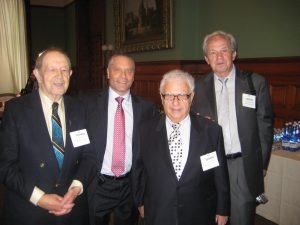Backstory is a CJN column recalling some of the most bizarre, unique, and important moments in Jewish history. Click here for last week’s instalment.
As an infant, hidden in occupied France during the Holocaust, whose father and his father’s family perished in Auschwitz, I grew up with a haunting legacy. Over the years, I wrestled with many aspects of this history.
My mother was five months pregnant with me, and she was left with her two little girls, when my father was arrested in the first nationwide roundup of Jews in France, on July 16, 1942. When I was much older, she told me that once, prior to his arrest, she had removed her yellow star and travelled to Paris from the town of Château Gontier where our family was in enforced residence. When she arrived she was caught in large police dragnet of prostitutes and placed in a jail cell with them. Three days later, she was released and returned home.
READ: TRACING SURVIVORS AND VICTIMS OF THE HOLOCAUST
Late in my mother’s pregnancy, two SS or Gestapo officers came by car to the small town to arrest her and her two girls. In a last act of desperation she blurted out that she was about to give birth. Since she was very heavy with child, and since the officers realized what a childbirth would do to their Mercedes, they retreated, saying that they would return. Through the remarkable mind-numbing efforts of the extended Christian Counord-Gardon family, they failed in their mission. I was born, and they placed us in different hiding places for the duration of the war.
The Germans, realizing that their “prey” had eluded them, started hunting for us. They even interviewed my midwife who told them that Mme. Honig was so desperate that she probably jumped into the nearby Mayenne River with her children. When in 1980 I visited the people who had risked life, limb and torture to save us, I was told that the Germans dredged the river for three days in search of bodies, thereby allowing for more time to execute our escape.
I have in my possession a copy of a letter from the chief of the French police in Château Gontier to the commissioner of police for the province of Mayenne, stating that Mme. Esther Honig disappeared with her three children (names, and places and dates of birth included), and that he had no idea which direction she took. But he assured his superior that as soon as he found the whereabouts of the “fugitives” he would let him know. The letter was dated Nov. 24, 1942. So my mother was labelled a fugitive, and by extension I was too, at the age of three weeks.
When I was 50 years old, I visited my mother in Montreal, and together we watched a video of the Holocaust interview that she had at the Living Testimonies Project at McGill University. There and then I finally learned the reason for her surreptitious nighttime trip to Paris where she was arrested and eventually released. She was going to an underground clinic to have an abortion! When she stepped out of the jail, she didn’t know where to go. One direction led to the clinic and the other direction led to home. Then she saw a German soldier across the street and she said to herself that what she could do with two children, she could do with three. And she left for home – and I was born.
READ: HOLOCAUST DOCUMENTARY SHOWS THAT EVERY FACE HAS A NAME
The revelation that I was almost aborted reeled me. But it was my mother’s courage, and the realization that I ended up being the vehicle for the saving of my mother and my two sisters, not to speak of me, that has haunted me for years. Now I realize that for almost two years, we all had near-death experiences, though only my mother was aware of the true danger at the time. As an infant, I could have no understanding of what transpired then. Yet it was surely the near-death experiences that have shadowed me in my cognitive years.
Eli Honig taught physics at the Anne and Max Tanenbaum Community Hebrew Academy of Toronto for 31 years, and for longer than that at the University of Toronto, where he continues to teach part time.






